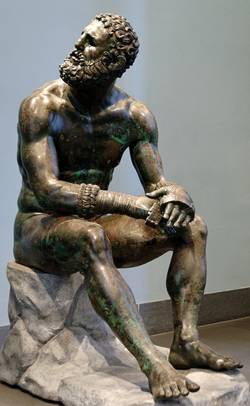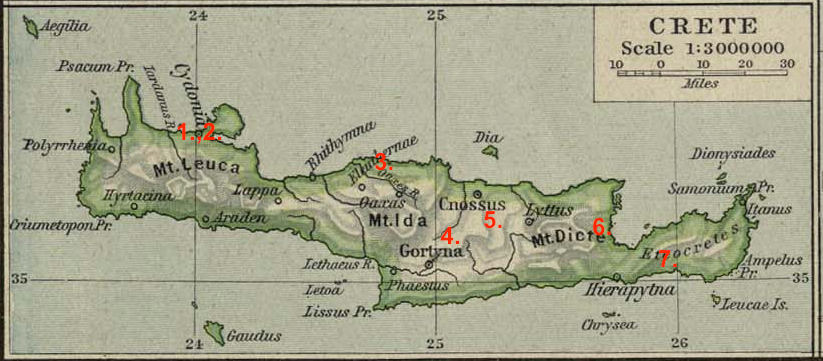“Power and Pathos. Bronze Sculpture of the Hellenistic World” is the penultimate exhibition to be held under the mandate of James Bradburne, Director General of the Fondazione Palazzo Strozzi. Bradburne has succeeded in turning the palazzo into Florence’s most important exhibition space.

And no more fitting show could have taken place to mark the end of his tenure: it is filled with great masterpieces, and accompanied by a scholarly catalogue. When it closes in Florence (on 21st June) it will travel first to the Getty Museum in Los Angeles (until 1st November) and then to the National Gallery of Art in Washington (until 20th March 2016).
Perhaps the most striking feature of the exhibition is the consistency it reveals in the styles of masters working in the Alexandrine world of Greece and during the later Roman era. A map (also reproduced in the catalogue) records the extraordinarily wide geographical area where the pieces have been found, either underground or underwater. The exhibition has deliberately concentrated on the “explicitly ‘un-ideal’: the innumerable contingencies of real-life physiognomy” which are the feature of Hellenistic art. But the curators of course were faced with the fact that so little bronze sculpture (as opposed to marble sculpture) survives because it was so often melted down. A tragedy because the skill (and technical ability) of the sculptors was never again equalled until the Renaissance.
To set the tone of the display (which is not chronological), the first room has just two exhibits. The first is a bare limestone base with its statue missing, which is here because it bears the signature of the greatest Hellenistic sculptor, Lysippus of Corinth, who was Alexander the Great’s court sculptor and who is reported by Pliny to have made no fewer than 1500 bronze statues. Not one of these survives, but other statue bases like this one can still be seen in Greece. The other exhibit is the splendidly-displayed Arringatore, or Orator. Because it normally forms part of the collection of the Museo Archeologico Nazionale in Florence itself, it seems appropriate that it should be here to greet visitors, its right hand stretched towards us in a gesture usually interpreted as a call for silence. The Etruscan inscription on the toga tells us that the statue was made in Chiusi and it is dated to the late 2nd century BC.
The next room has another magnificent piece from the same museum, the Medici-Riccardi Head of a Horse. Examination of its copper-tin alloy during its restoration for this exhibition has confirmed its date of the second half of the 4th century BC. It belonged to Lorenzo the Magnificent and is to this day perhaps the most important classical bronze in Florence. Beside it is displayed a very well-preserved statuette (found in Herculaneum) of Alexander the Great mounted on his famous steed (the mane worked in just the same way as the larger head), with silver trimmings (one of many important pieces from the Archaeological Museum in Naples loaned to this exhibition).
Two very different but memorable portrait heads dating from the 3rd century BC are also in this room: that of Queen Arsinoë III of Egypt, and an unknown man, much less regal, wearing a flat leather cap (known as a kausia). He was fished up in the Aegean sea in 1997 and it has been lent by the local museum of Pothia on Kalymnos, in the Dodecanese. This is one of numerous underwater finds which have been made in recent years, and it is always good to learn, as in this case, that they have remained close to where they were found. This piece is an almost miraculous survival: its flashing eyes, made of alabaster and faïence, are still intact and it takes an honourable place alongside works of much greater fame and from much more accessible museums.
In the third room we come face to face with the famous, over life-size Boxer (from the Museo Nazionale in Palazzo Massimo alle Terme in Rome), as he sits to regain his strength, his hands strongly bound up in leather and with clear signs (made with copper inlays) of combat on his scarred face with its broken nose. Dating from the 3rd century BC and unearthed in the 19th century on the Quirinal hill, this would have been brought back to Rome as war booty and exhibited in a public place as an example of the highest expression of art known at the time, an accolade it holds to this day.
Close by, in strong contrast, is a little brown statuette from the Metropolitan Museum of Art of an elderly man in a short tunic with a notebook tucked under his belt: he only has one leg and an arm is missing but he is thought to represent an artisan. Also from the same museum comes an exquisite statue with a green patina of Eros fast asleep: depicted as an infant with exquisitely carved wings, this is the forerunner of many depictions of cupids, cherubs and putti in Western art. A statuette of Hermes in his flat hat is a beautiful work lent by the British Museum, somehow typical of that museum’s extraordinary collection of masterpieces, not all of them as well known as one would expect.
The ‘pathos’ of the exhibition’s title is summed up in the portrait of a man from Delos, one of the best-known of all Greek portraits, lent from the Archaeological Museum in Athens. He has a furrowed brow above piercing eyes made of glass paste and black stone. It is exhibited near two other portrait heads: one from an Etruscan votive statue thought to have been found on an island in Lake Bolsena in 1771 (and now in the British Museum) and the other from the Bibliothèque Nationale in Paris, an extraordinarily refined work which retains even its eyelashes and its unshaven chin, also found in Italy (in 1847), and a very early example of Etruscan/Italic/Roman art (late 4th century BC).
The famous Greek bronze Apoxyomenos (the athlete scraping himself down with a strigil) from Ephesus is represented by a replica from Vienna (spectacularly restored in 1902 after it had been found in 234 pieces) and the head of an athlete purchased through Sotheby’s by the Kimbell Art Museum at Fort Worth in 2000 (with a long pedigree including its presence in an 18th-century collection in Venice). A Roman marble statue the Uffizi here is also derived from the Apoxyomenos (wrongly restored in the Renaissance to hold a marble vase instead of a strigil).
Two more statues come from Florence’s Archaeological Museum: the Minerva of Arezzo, derived from a statue of the Praxiteles school (of which numerous copies have survived); and, in the last room, the so-called Idolino, which dates from around 30 BC and would have served as a lamp-stand at banquets. Its very beautiful head shows great similarities to that of the lovely small bust of an Ephebe from Benevento (lent from the Louvre and exhibited beside it) with red copper lips: this is dated a few decades before the Idolino.
Florence’s Archaeological Museum have been involved as partners in this exhibition and in fact have produced their own little show in conjunction with the main one (it also runs until 21st June). Entitled “Small Great Bronzes: Greek, Etruscan and Roman Masterpieces from the Medici and Lorraine Collections”, it shows some of the museum’s most precious possessions, arranged by type
by Alta Macadam. Alta is the author of Blue Guide Florence and Blue Guide Tuscany, available in both print and digital format.







